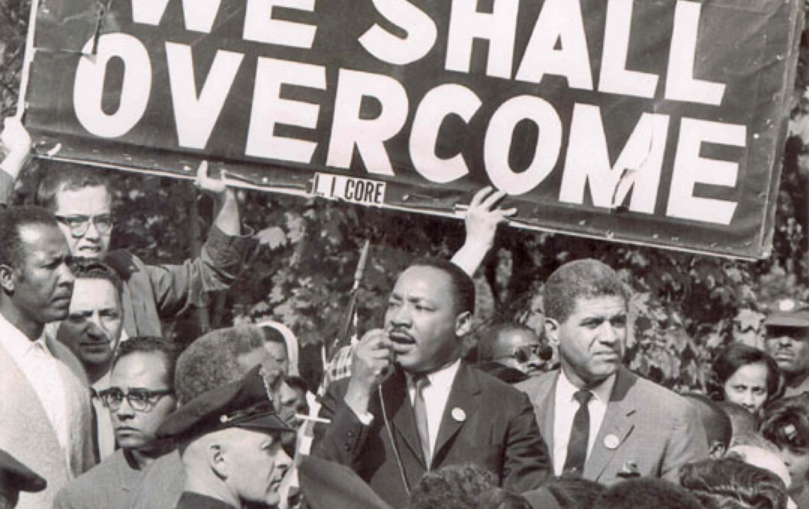Table of Contents
PEOPLE WHO MADE A DIFFERENCE
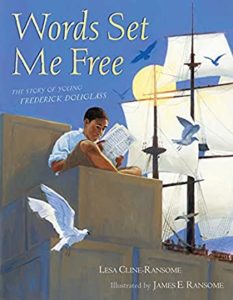 |
Lisa Cline-Ransome’s Words Set Me Free (Simon & Schuster, 2012) is a picture-book biography of Frederick Douglass, told in the first person. For ages 5-9. |
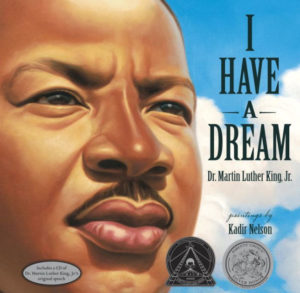 |
Illustrated with beautiful paintings by Kadir Nelson, Martin Luther King, Jr.’s I Have a Dream (Schwartz & Wade, 2012) captures the passion of one of the most famous speeches of the 20th century. For ages 6 and up.
|
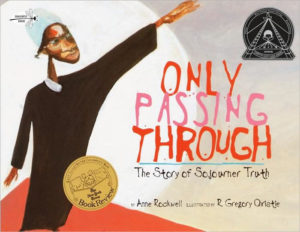 |
By Anne Rockwell, Only Passing Through (Dragonfly, 2002) is a picture-book biography of Sojourner Truth, who survived slavery to become a brave and eloquent spokesperson for abolition and women’s rights. For ages 6-9. |
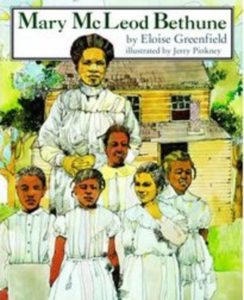 |
By Eloise Greenfield, Mary McLeod Bethune (HarperCollins, 1994) is the story of the brilliant educator and civil rights activist who worked to provide schools for African Americans in the late 19th and early 20th centuries. For ages 6-9.
|
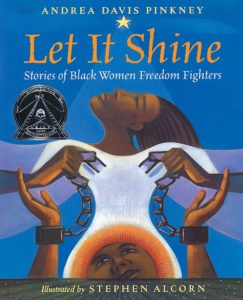 |
Andrea Davis Pinkney’s Let it Shine (Houghton Mifflin Harcourt, 2013) is an illustrated collective biography of black women freedom fighters, among them Sojourner Truth, Harriet Tubman, Ida B. Wells, Mary McLeod Bethune, Ella Josephine Baker, and Shirley Chisholm. For ages 6-9.
|
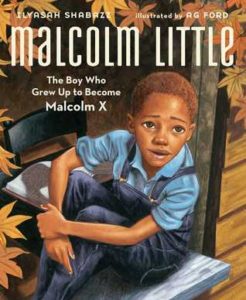 |
Malcolm Little: The Boy Who Grew Up to Become Malcolm X (Atheneum, 2014) is a picture-book biography by Ilyasah Shabazz, Malcolm X’s daughter. For ages 7-11.
|
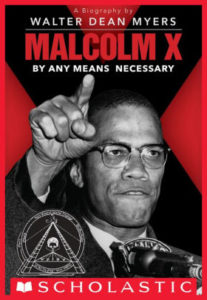 |
By Walter Dean Myers, Malcolm X: By Any Means Necessary (Scholastic, 2019) is a prize-winning biography for ages 12 and up.
|
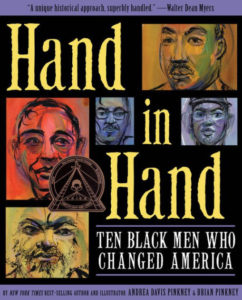 |
By Andrea Davis Pinkney, Hand in Hand (Little, Brown, 2012) tells the stories of “ten bold men who build a chain called hand in hand…working toward freedom.” Among these: Benjamin Banneker, Frederick Douglass, Thurgood Marshall, Malcom X, and Martin Luther King, Jr. For ages 8-12.
|
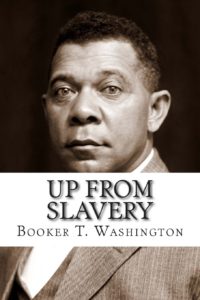 |
By Booker T. Washington, Up From Slavery (many editions) is the autobiography of the American educator, author, and presidential advisor, who was a key leader in the African-American community in the late 19th and early 20th centuries. A classic for teens and adults.
|
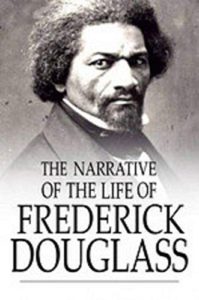 |
By Frederick Douglass, Narrative of the Life of Frederick Douglass (many editions), originally written in 1845, is the autobiography of the brilliant writer whose harrowing story and passionate voice inspired the abolitionist cause. A classic for teen and adults.
|
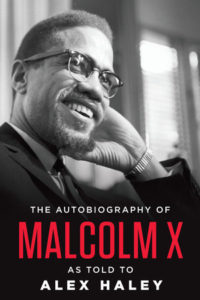 |
Dubbed one of the most important nonfiction books of the 20th century, The Autobiography of Malcolm X (Ballantine, 1992) is based on a series of interviews conducted over two years, from 1963 to Malcom X’s assassination in 1965. It’s the story of the fiery human rights activist and his promotion of black pride and black nationalism, as well as an account of his personal spiritual journey. Highly recommended for teens and adults. |
CIVIL RIGHTS
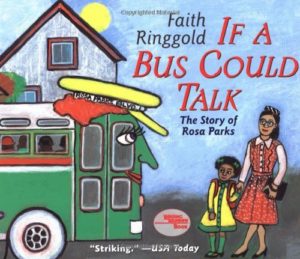 |
In Faith Ringgold’s picture book If A Bus Could Talk (Aladdin, 2003), a talking bus tells Marcia the story of Rosa Parks, mother of the Civil Rights movement. For ages 4-8. Also see Pamela Duncan Edwards’s The Bus Ride That Changed History (Houghton Mifflin Harcourt, 2009) and Jo S. Kittinger’s Rosa’s Bus (Calkins Creek, 2010). |
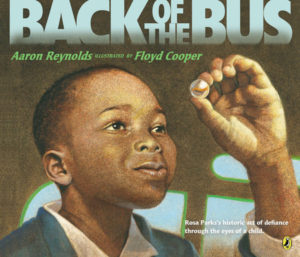 |
Aaron Reynolds’s Back of the Bus (Puffin, 2013) is the story of Rosa Parks as told from the point of view of a small black boy sitting in the back of the bus and playing with a marble. For ages 5-8.
|
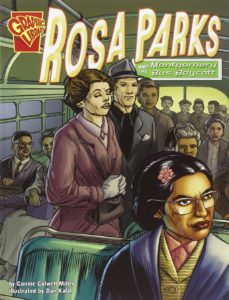 |
Connie Rose Miller’s Rosa Parks and the Montgomery Bus Boycott (Capstone, 2006) is a graphic-novel version of the story for ages 9-12.
|
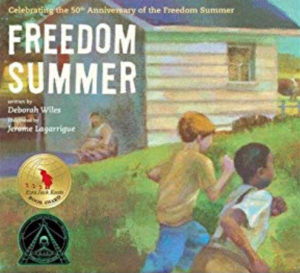 |
By Deborah Wiles, Freedom Summer (Atheneum, 2014) is the story of the friendship of two young boys, one black, one white, in the wake of the Civil Rights Act of 1964. “John Henry swims better than anyone I know./He crawls like a catfish/blows bubbles like a swamp monster/but he doesn’t swim in the town pool with me./He’s not allowed.” For ages 4-8. |
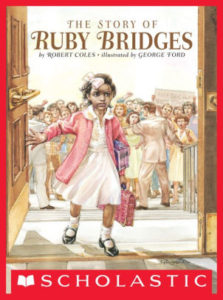 |
By Robert Coles, The Story of Ruby Bridges (Scholastic, 2010), is the story of six-year-old Ruby who, ordered by a judge to attend an all-white school, must cope with angry mobs of white protesters. For ages 4-8.
|
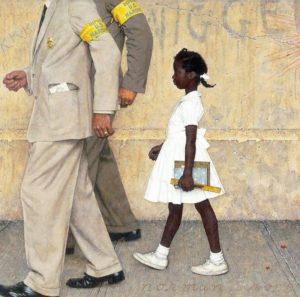 |
By Norman Rockwell, The Problem We All Live With, painted in 1963, is a portrait of little Ruby, flanked by U.S. Marshalls. Read about Rockwell and his Civil-Rights-era paintings here.
|
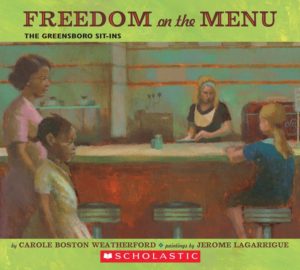 |
In Carole Boston Weatherford’s Freedom on the Menu (Puffin, 2007), eight-year-old Connie realizes that things could change when she sees four young men take a stand for civil rights at the Woolworth lunch counter in Greensboro, North Carolina. For ages 4-8. |
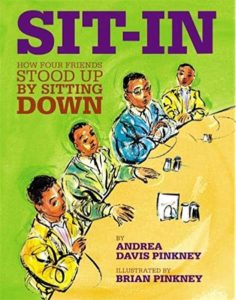 |
Andrea Davis Pinkney’s Sit-In: How Four Friends Stood Up by Sitting Down (Little, Brown, 2010) is a picture-book account of the famous Woolworth lunch counter sit-in, when four black college students staged a peaceful protest in Greensboro, North Carolina in 1960, and helped inspire the growing Civil Rights movement. Included are a Civil Rights timeline and suggestions for further reading. For ages 6-10. |
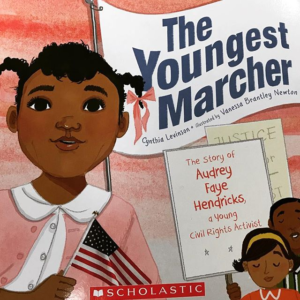 |
By Cynthia Levinson, The Youngest Marcher (Atheneum, 2017) is the story of nine-year-old Audrey Faye Henrick, the youngest person to be arrested for a civil rights protest in Birmingham, Alabama, in 1963. For ages 5-9.
|
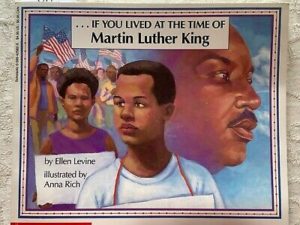 |
By Ellen Levine, If You Lived at the Time of Martin Luther King (Scholastic, 1994) describes what it was like to live in the days of segregation and the Civil Rights Movement. Readers learn about the Montgomery Bus Boycott, the Greensboro lunch counter sit-in, and the famous March on Washington. It’s written in a question-and-answer format which makes for an interactive read and promotes discussion. For ages 7-11. |
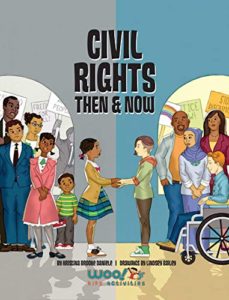 |
By Kristina Brooke Daniele, Civil Rights Then and Now (Wendybird Press, 2019) is a timeline of the long-going struggle for equality, with historical background, capsule biographies of key people, and descriptions of landmark court cases. Part One (Civil Rights Then) begins with abolitionists and early activists and proceeds through the Civil War and the Civil Rights era; Part Two (Civil Rights Now) deals with the modern Civil Rights movement and rising violence against black Americans. For ages 9 and up. |
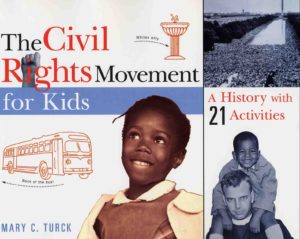 |
By Mary C. Turck, The Civil Rights Movement for Kids (Chicago Review Press, 2000) has historical background information, a timeline, capsule biographies of influential people, period photos, and 21 hands-on projects and activities. An appendix has additional resources and a book list. For ages 9-12. |
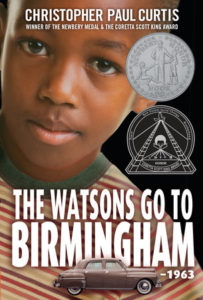 |
By Christopher Paul Curtis, in The Watsons Go to Birmingham – 1963 (Yearling, 1997), narrated by 10-year-old Kenny, the Watsons of Flint, Michigan, pile into their car, the Brown Bomber, and head for Birmingham, where they plan for older son Byron (an “official juvenile delinquent”) to live for a while with his grandmother. They arrive at the time of Birmingham’s 16th Street Baptist Church bombing, that killed four young black girls. For ages 9-12. |
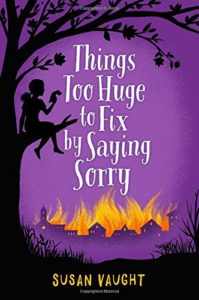 |
In Susan Vaught’s Things Too Huge to Be Fixed by Saying Sorry (Simon & Schuster, 2016), set in Oxford, Mississippi, black scholar Ruth Beans and white novelist Avadelle Richardson have had a long-standing rift. Ruth now has Alzheimer’s disease, but she’s left behind clues to the source of the problem, which Ruth’s granddaughter, Dani, and Avadelle’s grandson, Mac, are determined to solve. The truth lies in the struggle for civil rights, the turbulent desegregation of the University of Mississippi in 1961, and the toxic legacy of racism. For ages 10-14. For more info on the desegregation of the University of Mississippi, see James Meredith at Ole Miss. |
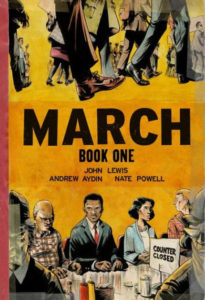 |
Congressman John Lewis’s March (Top Shelf, 2013), winner of a National Book Award, is the first of a graphic-novel trilogy about Lewis’s lifelong fight for civil rights. An eyewitness story of social change for ages 13 and up.
|
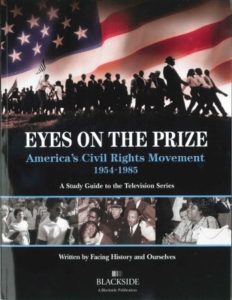 |
From PBS’s American Experience, Eyes on the Prize is a highly acclaimed nine-part history of the American Civil Rights Movement, featuring contemporary interviews and historical footage. Also see this selection of “must watch” black history documentaries.
|
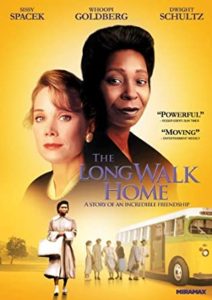 |
In The Long Walk Home (1990), two women in Montgomery, Alabama, one black, one white – respectively played by Whoopi Goldberg and Sissy Spacek – must decide what to do during the Montgomery Bus Boycott of 1955, the first large-scale demonstration in opposition to segregation. Rated PG. For more info, also see Montgomery Bus Boycott from History.com. |
